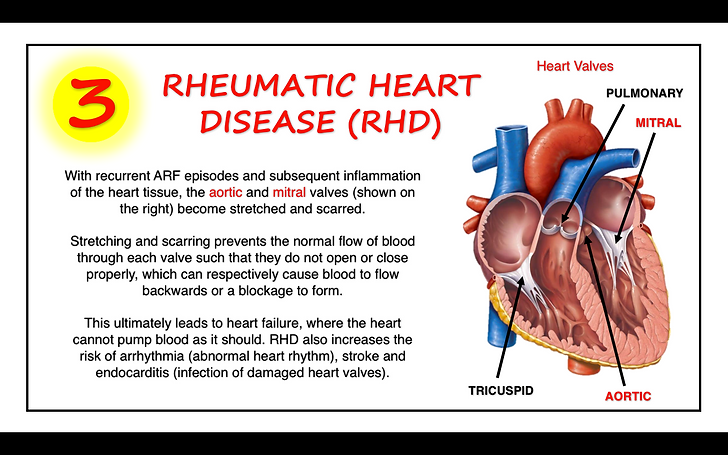

What is Acute Rheumatic Fever (ARF) and Rheumatic Heart Disease (RHD)?
Posted 11th February, 2017











Financial Cost to the Patient and the Level of Physical Pain Experienced
With each stage, the financial burden increases and more physical pain is experienced
Prior to examining the experience of Indigenous Australians specifically, it is important to understand the progression of disease that leads to both ARF and RHD.
It all begins with acute bacterial pharyngitis - known as 'strep throat' - following infection by Group A streptococcus (most prominently Streptococcus pyogenes). Certain determinants - such as environmental factors (overcrowding), genetics and bacterial characteristics (bacterial subtype) - mean that approximately 3% of children with strep throat are susceptible to acute rheumatic fever (ARF) [1]. This is an autoimmune response to the bacterial infection where a variety of body tissues, notably including the heart, become inflamed [2]. Heart valve health deteriorates with carditis (inflammation of the heart) following each episode of ARF, leading to rheumatic heart disease (RHD). As the progression of disease takes place, the financial cost to the patient, community and wider society plus the level of physical pain experienced escalates [3]. The graphic below further explores each stage, detailing associated symptoms.
Diagnosis
The diagnosis of ARF requires clinical assessment by a medical practitioner, with identification of major and minor signs and symptoms. Major signs and symptoms are strongly associated with ARF, such as carditis, polyarthritis, chorea, erythema marginatum and subcutaneous nodules. Minor signs and symptoms support the diagnosis and include fever, arthralgia (joint aches) and a previous ARF episode. The Jones Criteria for diagnosing an initial episode of ARF requires either 1 major and 2 minor symptoms, or 2 major symptoms, alongside evidence of GAS infection (for example strep antibodies or recent scarlet fever) [4,5].
Early and accurate diagnosis of ARF is essential to prevent disease progression [5].
Standard guidelines have been developed to diagnose RHD using echocardiography (ultrasound of the heart), however it is also known to produce a cardiac murmur distinctively heard through a stethoscope. Unfortunately many cases of RHD remain undiagnosed for years because symptoms are not noticed. A medical specialist with expertise in RHD diagnosis is also required to confirm a suspected case [4,5].
Treatment
Where a symptom of ARF will not resolve on its own, antibiotics can be prescribed to manage it. Joint pain and fever will settle within 24 hours of oral aspirin being taken. Corticosteroids can be used to treat severe carditis. Penicillin helps clear the original GAS infection and is required to be taken for at least 10 years after an ARF episode to prevent recurrences [5].
Long-term adherence to medication and regular review are critical factors determining successful treatment [5].
Regular checks with a rheumatologist, paediatrician or cardiologist are required to monitor the condition of the heart. If damage to the heart valves becomes severe, surgery can serve to prolong life and reduce the risk of stroke, arrhythmia and endocarditis, but never completely cure RHD. Heart surgery seeks to repair the damaged valve, or in the worst case, completely replace it with an artificial valve [5].

References
[1] Wyber R. Indigenous Australia left behind in rheumatic heart disease fight [Internet]. The Conversation (Australia); 2014 [cited 2017 Feb 11]. Available from: http://theconversation.com/indigenous-australia-left-behind-in-rheumatic-heart-disease-fight-24346.
[2] Carapetis JR, Brown A, Wilson NJ, Edwards KN. An Australian guideline for rheumatic fever and rheumatic heart disease: an abridged outline. Med J Aust. 2007;186(11):581-6.
[3] WiRED International. Strep Throat to Rheumatic Heart Disease [Internet]. Youtube; 2015 [cited 2017 Feb 11]. Available from: https://www.youtube.com/watch?v=NSJwthP7c9s.
[4] Carapetis J, Brown A, Maguire G, Walsh W, Noonan S, Thompson D. The Australian guideline for prevention, diagnosis and management of acute rheumatic fever and rheumatic heart disease (2nd edition). Casuarina: Menzies School of Health Research; 2012.
[5] RHD Australia. How is it diagnosed and managed? [Internet]. Casuarina, NT (Australia): RHD Australia; 2016 [cited 2017 Feb 11]. Available from: http://www.rhdaustralia.org.au/how-it-diagnosed-and-managed.
Note: Individual images used in the graphic above were sourced from Google Images: https://images.google.com/?gws_rd=ssl